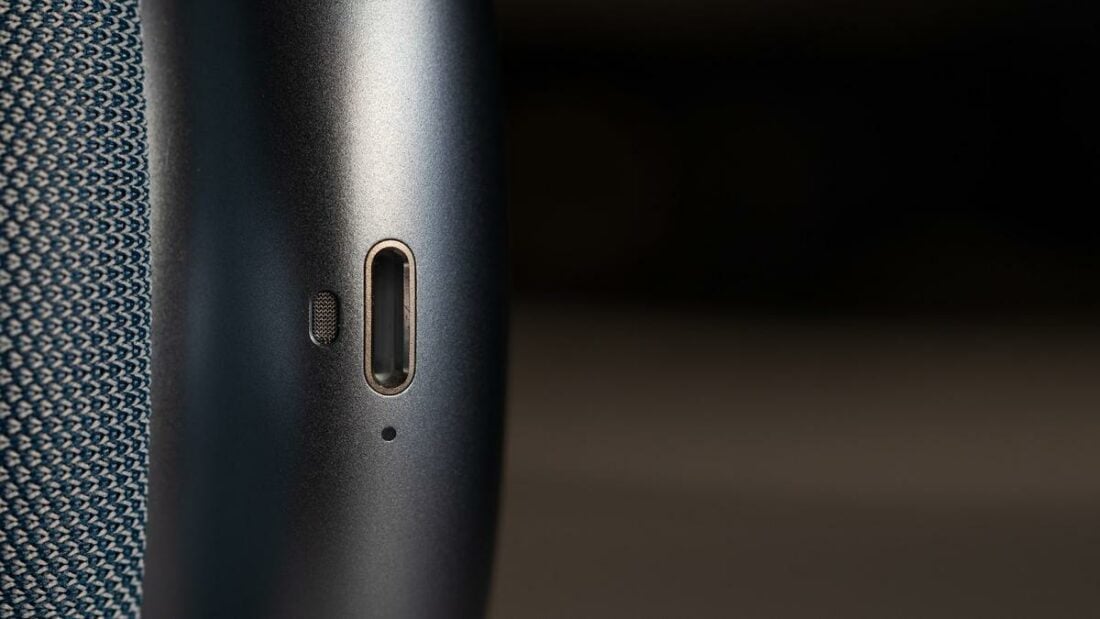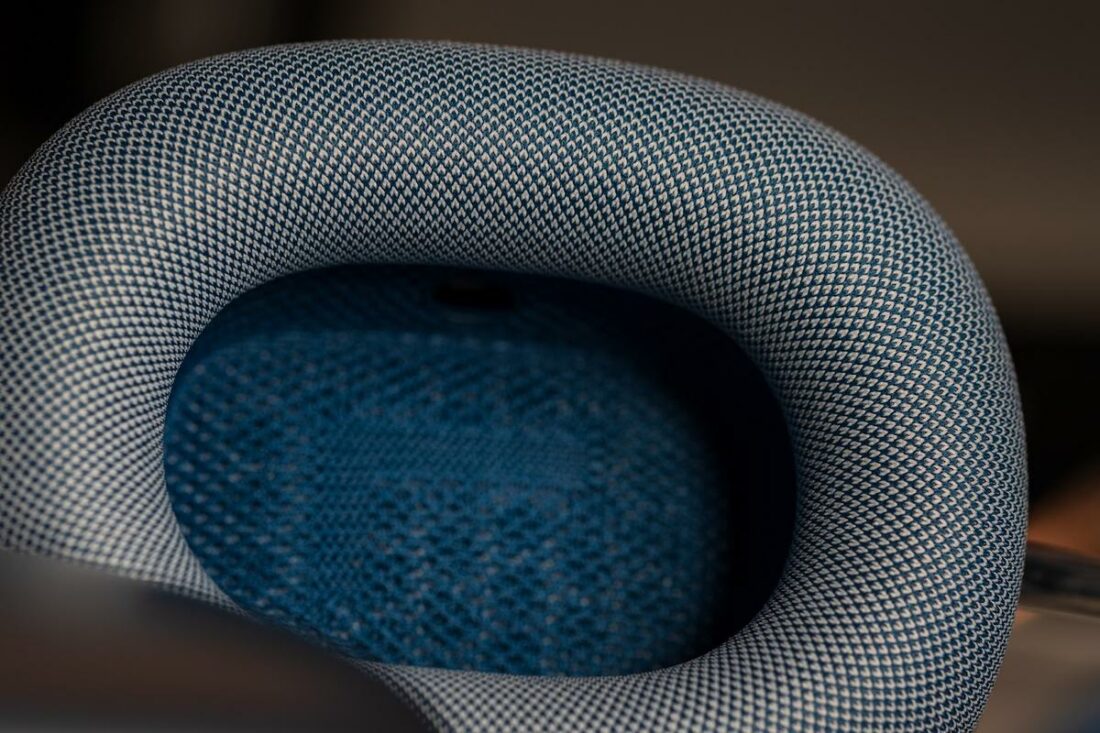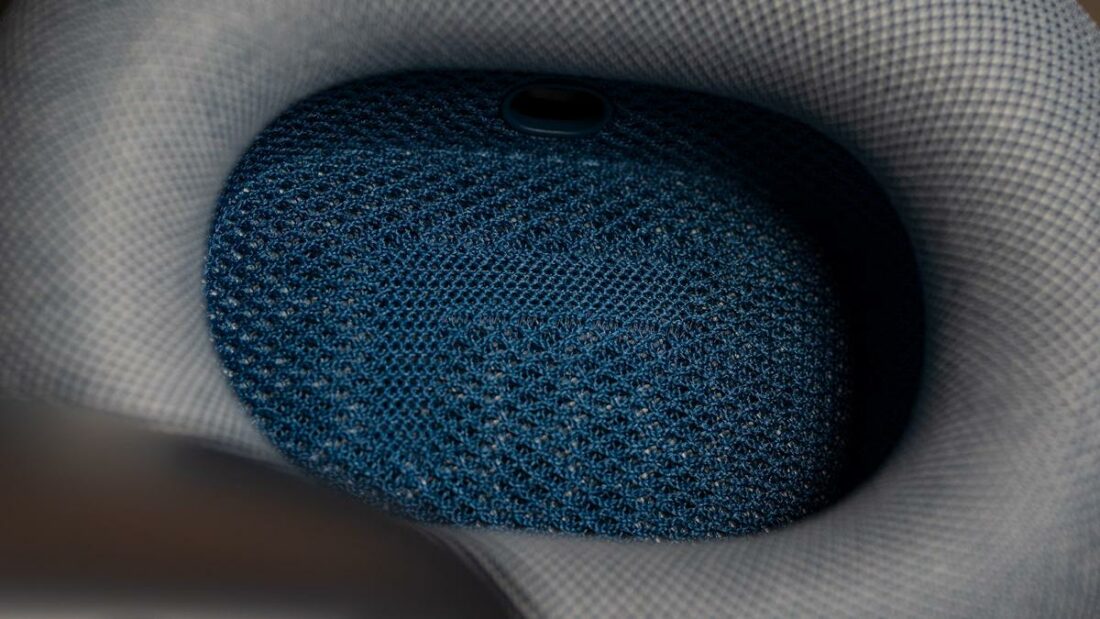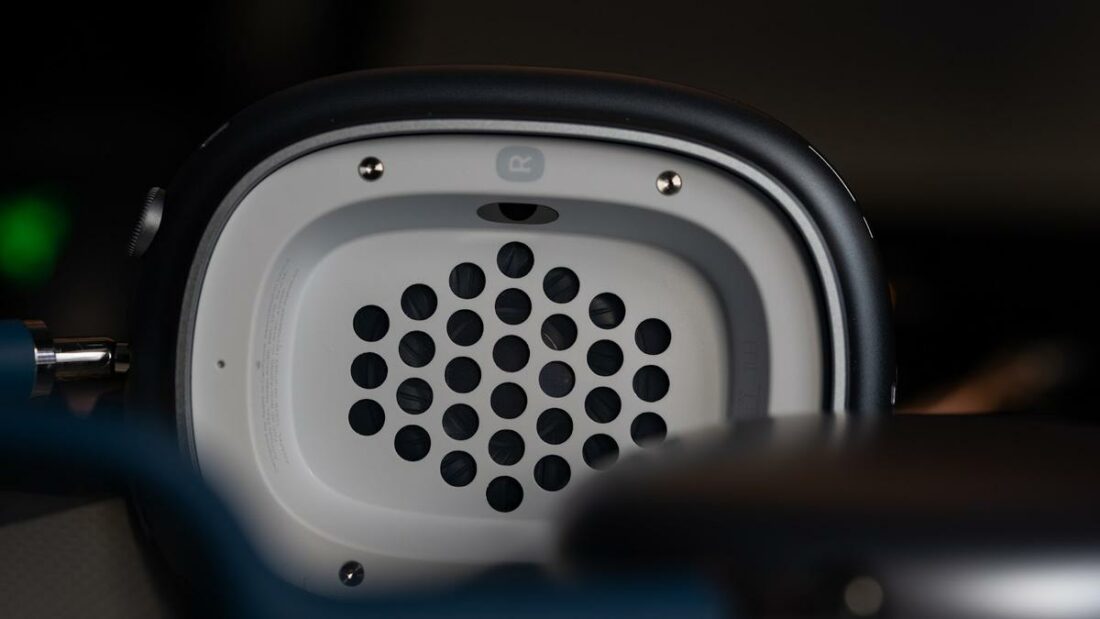Apple’s flagship headphones retain their statement design and consumer appeal, but other aspects show signs of age.
- Class-leading build quality and craftsmanship
- Excellent noise cancellation performance
- Easy-to-use and reliable mechanical controls
- Mostly pleasing tuning with good bass and mids
- Great integration into Apple’s ecosystem
- Absurd reliance on an ugly carrying case
- Mic performance could be better
- Customizing the sound is a convoluted, opaque process
- High clamp force creates discomfort
- Treble peak around 9kHz
- No “lossless” codec support
- No analog input
- Very limited functionality when connected to Android of Windows devices
- Expensive
Where to Buy
Introduction
Apple sort of broke the internet back in December 2020 when they announced the Airpods Max, their first-ever full-sized Bluetooth headphones, with a price tag to match their uniqueness.
It’s been over two years since then, and the Airpods Max are still the top dog in Apple’s lineup. They are also one of the most expensive Bluetooth headphones around, although the competition has managed to surpass them in the pricing department.
At launch, the Airpods Max offered features that outperformed most competitors. Two years is a long time, though, long enough to show the age of most products.
So, do the Airpods Max survive the test of time, or are they merely still enjoying the limelight courtesy of brand value? Let’s find out.
Packaging
Apple does not bother with fancy packaging, and that trend continues here. You only get the bare minimum inside, with no special perks for buying their flagship headphones. A letdown, indeed.
In the box
- Apple Airpods Max headphones
- USB-C to Lightning charging cable
- Manuals
- Smart Case
The so-called “Smart Case” offers little protection, does not cover the entire headphones, and attracts dirt and lint like a magnet.
It mimics a certain undergarment, and worst of all, you cannot avoid using it as the headphones only go to deep sleep when put in the case.
For a brand as design-conscious as Apple, such a terrible case design is nothing short of an abomination.

Battery ⓘ
- Battery Life: 20 hrs (with ANC and Spatial Audio on)
- Charge Time (5 mins): up to 90 mins playback time
At around 20hrs, the battery life of the Airpods Max is merely average, given the competition is pushing 80 hours of playback. I need to charge the headphones once every week, with moderate usage.
5 mins of charge can get up to 1.5 hours of playback, provided you have a suitable USB-PD adapter and cable.
The quick charge function is handy, but the competition offers even better quick charge performance.
UX ⓘ
- Control Mechanism: Mechanical
- Touch Accuracy: N/A
- Control Symmetry on both ear-cups: No
- Mono Use: No
- Each earcup has an Apple H1 chip
- A proximity sensor in each earcup for wear-detection
Apple has repurposed its “Digital Crown” navigation system from the Apple Watches. You can rotate the crown to increase or decrease the volume, while a middle press plays/pauses music playback or answers/ends a call.

Aside from the crown, there is an ANC button that can be used to switch between ANC or Transparency mode.
The controls are decidedly simple and very easy to get used to. Another nifty feature is that the headphones automatically switch to transparency mode if only one of the earcups is moved away from the ear.

Design ⓘ
- Profile: Over-ear
- Material: Aluminum
- Fit and Comfort: Substandard
Apple Airpods Max are built more like a mechanical watch than traditional pair of headphones.
The entire construction is aluminum, with antenna lines etched onto the surface like modern smartphones. This design decision allows for RF transparency despite a metal chassis, something I hope other manufacturers pick up.
The headband is a two-piece construction with the inner steel frame adding rigidity and the outer silicone-coated frame housing the suspension band. The adjustment mechanism is stepless, so you never quite know how much the headband is extended.

The right side earcup houses the Lightning port with fast-charging support alongside the buttons for playback control and ANC.

The left earcup is bereft of any controls or ports. Both earcups house a total of nine microphones strategically placed around the cups to attenuate noise.

The earpads are made out of breathable fabric, which can get dirty over time. The earpads are very easy to remove since they are simply mounted via magnets. A bit too easy since I accidentally removed them more than once.
The lack of analog input is another odd decision, as most of the competition has that feature.

The hinge mechanism allows for a 90-degree rotation of the earcups. The swivel mechanism is also spring-loaded – a novelty in the wireless headphones space.

The earpads themselves are comfortable, but the clamping force is overdone for my preferences, resulting in pressure buildup around the jaw area after an hour or so. The hefty 385g of weight does not help either.

Mic ⓘ
- Noise Cancellation: Soft Noise
- Voice Pick-up: Muffled
The 9 microphones placed around both earcups aid in noise cancellation and voice pickup. A couple of mics are inside the earcups themselves for the self-equalization function.
These mics form the basis of the exceptional noise cancellation.
They filter out low-frequency noises exceptionally well; high-frequency noises are filtered better than most of the competition. However, some high-pitched voices are not completely drowned out.
Mic demo
Sound ⓘ
- Driver: 40mm.
- Sound Signature: Warm, slightly V-shaped
- Bass: Good
- Mids: Good
- Treble: Average
- Soundstage: Good
- Imaging: Good
- Dynamics: Good
Apple doesn’t tell much about the driver setup apart from the driver diameter of 40mm. Looking at iFixit’s teardown I think it’s a PET diaphragm with a PVD plating. Judging by the black color, I assume it’s a carbon nanotube coating, as Sony WH-1000XM5 drivers have a similar look. Note that this is just conjecture on my part.
The Airpods Max have a warm, slightly V-shaped signature, with some boost in the sub-bass and peakiness in the treble.

Bass
The bass response is characterized by the noticeable sub-bass boost. Fortunately, the mid-bass is left untouched, resulting in a clean response with no bloat or bleed.
Bass is fairly textured but does not sound fast, partly due to the driver limitation and partly due to the lossy codecs taking a toll on the bass region.
Mids
The midrange has a natural voicing, with no shout in the upper-mids, or any hollowness or “honk” in the lower-mids. The slight recession in the lower mids tends to drown out male vocals in some tracks with lots of instrumentation, but that’s about it.
The Airpods Max are good at reproducing both vocals and string instruments. Acoustic guitars sound especially nice, with crisp attack and natural decay. Overall, a job well done.
Treble
The treble is where the Airpods Max become polarizing. A noticeable peak around 9KHz and a couple more in the upper-treble region tends to cause fatigue. This can be heard in tracks like Tool’s Chocolate Chip Trip, where the sharp cymbal hits can get distracting after a while.
The graininess in the treble is another negative, with resonances sounding overly compressed.
Dynamics
Macrodynamic punch (sudden changes in volumes, e.g. bass drops) is presented well, but the microdynamics (subtle shifts in volume) are barely perceptible.
In tracks like Counting Crow’s Miami, the vocals and the instrument have a continuously varying volume level, and the Airpods Max cannot recreate that sensation.
Soundstage
The soundstage has good width, though the depth is average. Given the context of closed-back BT headphones, the Airpods Max perform well here, even if the end result is not groundbreaking.
Imaging
Imaging is surprisingly solid, with good left and right delineation. Ordinal imaging (top-left, bottom-right) is a weak spot, and so is center-imaging.
This changes when it comes to Spatial Audio files, though, as there is a convincing rendition of space around you. Localization is noticeably improved and gives a sense of realism that is hard to find in competing products.
Sadly, many albums are not mastered with Spatial Audio in mind, and, in movies, the head-tracking feature feels more like a gimmick than something useful. Moreover, the music itself sounds overly processed and unnatural, so I never used this feature again once the novelty wore off.
Active noise cancellation
With the ANC turned on, the treble peakiness of the Airpods Max is slightly increased. The remaining frequencies do not have a noticeable change.
I recommend keeping ANC on in most cases, as that’s the feature you are paying for.
Connectivity ⓘ
- Audio Codec: SBC, AAC
- Bluetooth Version: 5.0
- Auto-connect when: Picked up or worn
- Average drop-outs in an hour: 0 – 2 times
- Multi-point connection: Yes
The connection is rock-solid, and pairing is fairly simple once the headphones are put in pairing mode (pressing the power button for 5 seconds or so). Multipoint support is seamless as well, especially if you are using Apple devices.

Waterproof ⓘ
- IP Rating: Not rated.
No official IP rating here, which is a bummer.
Software ⓘ
- No separate software
- Auto EQ feature
- Spatial Audio (requires specific files and hardware)
- Ability to save and import profiles across Apple devices
- Auto Pause: when taken off the head.
Apple does not have separate software to control or customize the Airpads Max. Instead, Apple expects users to own an iPhone and manage things from there. You can tune the sound to a degree in the settings app, but it’s buried deep. You can look at the steps required here in detail.
Comparisons
Apple Airpods Max Vs. Sony WH-1000XM5
The Sony WH-1000XM5 launched over a year after the Airpods Max, so Sony had ample time to catch up to the competition and even surpass it.
Unfortunately, one area where Sony couldn’t redefine the status quo is the build. The WH-1000XM5 are generic to the point of being boring. They look professional and are comfortable (far more so than the Airpods max), but they lack the glamour, charm, and character that the Airpods Max exude.
Fortunately, the story gets better from here for Sony. The Sony WH-1000XM5’s control mechanism is more versatile and customizable than the Airpods Max. Sony’s Headphones app offers DSP effects to further enhance the sound, and they support LDAC codecs with high bitrate transmission.
The Sony WH-1000XM5 also have well-rounded EQ support and analogous features to Spatial Audio and Apple’s Auto EQ features.
Now, let’s get into the sound. WH-1000XM5 have a darker, smoother tuning, whereas the Airpods Max tend to sound brighter. The bass is better defined on the Airpods Max due to a more controlled boost, while the mids are less recessed.
Treble is the area where I prefer the smoother, cleaner presentation of the Sony, as the peaky, grainy nature of the Airpods Max’s treble tends to be too distracting. Staging is similar, and so is the imaging with regular music files.
Microdynamics are superior on the WH-1000XM5, whereas Airpods Max edge them out in terms of macrodynamic punch.
The ANC performance is another back and forth between these headphones since the Sony offerings are better at filtering high-frequency noise at the expense of a vacuum effect. In contrast, the Airpods Max have a better Transparency mode.
At the end of the day, I imagine the choice between these two headphones will be a simple one: if you are part of the Apple ecosystem and do not own Android or Windows devices, the Airpods Max offer a more seamless integration. For those requiring more versatility, you cannot go wrong with the WH-1000XM5.
Conclusion
The Apple Airpods Max look good, feel unique, and offer mostly good sound quality. The easy synchronization and connecting with Apple devices remain their calling card, and the intangible “clout” of Apple products is definitely enticing.
Sadly, these headphones are showing their age. The codec support is pedestrian, the battery life is unremarkable, and the lack of versatility with non-Apple products remains a personal pet peeve. Add to that the high price tag and the Airpods Max are not something I’d label as a “value proposition.”
Then again, value is never the agenda in Apple’s mind. It wants to offer something uniquely “Apple” that further ties the owners into its ecosystem, a walled garden with outsiders looking in and contemplating why anyone would ever shackle themselves to something so inhibiting.
